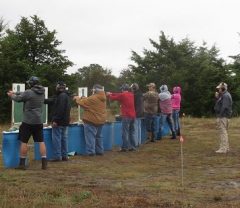I have written before about action types and trigger types, but now we need to discuss the Manual of Arms. This refers to the actual operation of a gun, sometimes called “running the gun”. While this relates mostly to someone who carries a gun on their person, it also applies to someone who stores a gun at home. More than one person has retrieved a gun in an emergency, only to discover that it was not immediately dischargeable, and they weren’t sure how to recover. There are two questions, the answers to which will vary depending on the type of gun:
- in what condition should this gun be carried (or stored)?
- what steps are necessary to make it dischargeable?
I will start with the simplest type, and move toward the more complex.
Revolver. Most are double-action (DA), which means they can be fired cocked (single-action) or uncocked (double-action). It is a common convention to only fire them in DA mode, and they must never be carried or stored in single-action. Some revolvers are double-action only (DAO). There is no safety, so running the gun simply means point and shoot.
Revolver (SAO). It would be uncommon for someone to have a single action revolver (which can only be fired when cocked), and not know this, as these are typically used for competition, but these guns should never be carried with a round under the hammer.
Semi-automatic (striker-fired). These guns do not have an external hammer, and often do not have a safety. They should be carried with a round in the chamber, and safety off. On presentation, take off the safety (if on) and press the trigger. In a crisis, if you forget the safety, or cannot take it off in less than 1 second, you are in trouble.
Semi-automatic (hammer-fired, SAO). Many hammer-fired guns are single-action only. When you rack the slide to charge the chamber, the hammer is cocked, and the gun will not fire if it is decocked. These are carried “cocked-and-locked” (safety on). On presentation, take off the safety and press the trigger. Another option is to not have a round in the chamber (only advisable at home). Yet another option is to rack the slide and manually decock the hammer (this is dangerous). On presentation, cock the hammer with your thumb.
Semi-automatic (hammer-fired, DA, with safety and no decocker). Same as above, except that, when decocked, it is not necessary to cock the hammer. The trigger will do that. On presentation, (if safety on), take off the safety and press the trigger. If decocked, just press the trigger. It cannot be decocked with the safety on. **
Semi-automatic (hammer-fired, DA, with decocker and no safety). Same as above, except there is no safety. After racking the slide, you must carry the gun decocked. On presentation, just press the trigger. **
Semi-automatic (hammer-fired, DA, with both safety and decocker). Some Beretta models have this odd combination. After racking the slide, when you put on the safety, it automatically decocks the hammer. On presentation, you must take off the safety first. **
** When firing a decocked, double-action gun, the first pull of the trigger is long and relatively heavy, by design. Since the gun always resets itself on firing to single-action (cocked), all subsequent pulls will be short and easy. It takes some training to get used to this, and many people will prematurely discharge the second round. It is due to this training issue that most police departments use striker-fired guns, where every trigger pull is the same.
It is important that you train around the proper operation of your gun so that you don’t fumble in a crisis. A drill I recommend is loading your gun, and putting it in the condition you would carry it (safety on, decocked, etc.). Place it on a bench (on in a holster, if that is allowed), and put a silhouette target at 3 yards distance (later, at 5 yards). Track the time it takes to retrieve the gun, make it dischargeable, and put two good shots in center mass. The goal is three seconds. Repeat as necessary.
